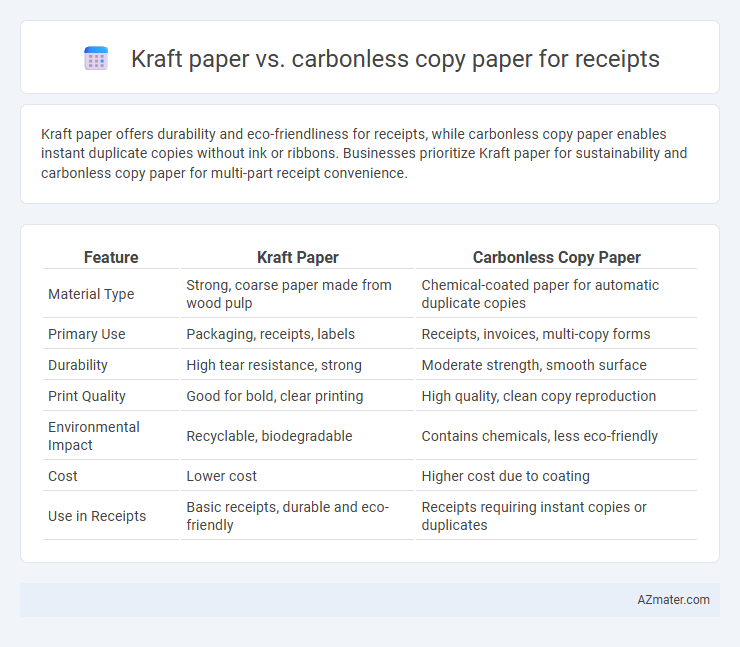Kraft paper offers durability and eco-friendliness for receipts, while carbonless copy paper enables instant duplicate copies without ink or ribbons. Businesses prioritize Kraft paper for sustainability and carbonless copy paper for multi-part receipt convenience.
Table of Comparison
| Feature | Kraft Paper | Carbonless Copy Paper |
|---|---|---|
| Material Type | Strong, coarse paper made from wood pulp | Chemical-coated paper for automatic duplicate copies |
| Primary Use | Packaging, receipts, labels | Receipts, invoices, multi-copy forms |
| Durability | High tear resistance, strong | Moderate strength, smooth surface |
| Print Quality | Good for bold, clear printing | High quality, clean copy reproduction |
| Environmental Impact | Recyclable, biodegradable | Contains chemicals, less eco-friendly |
| Cost | Lower cost | Higher cost due to coating |
| Use in Receipts | Basic receipts, durable and eco-friendly | Receipts requiring instant copies or duplicates |
Introduction to Receipt Paper Types
Receipt paper types primarily include Kraft paper and carbonless copy paper, each serving distinct purposes in transaction documentation. Kraft paper, known for its durability and eco-friendliness, is ideal for receipts requiring long-term handling, while carbonless copy paper facilitates multi-part receipts by enabling instant duplicate copies without carbon sheets. Choosing between these papers depends on the need for archival quality versus the convenience of instant copy generation in retail and business environments.
What is Kraft Paper?
Kraft paper is a strong, durable paper made from chemical pulp produced through the kraft process, known for its high tear resistance and natural brown color. It is commonly used for packaging, wrapping, and receipt printing where sturdiness and eco-friendliness are priorities. Unlike carbonless copy paper, which transfers ink to create duplicates, kraft paper is valued for its robustness and recyclability rather than its ability to replicate written content.
What is Carbonless Copy Paper?
Carbonless copy paper is specially coated to transfer information written on the top sheet to underlying sheets without the need for carbon paper, making it ideal for multi-part receipts and forms. Kraft paper, made from recycled wood pulp, offers durability and a rustic appearance but lacks the chemical coating necessary for producing copies. Businesses requiring instant duplicates typically prefer carbonless copy paper for efficient, clean, and legible receipt duplication.
Durability and Strength Comparison
Kraft paper offers superior durability and strength compared to carbonless copy paper, making it ideal for long-lasting receipts that resist tearing and wear. Carbonless copy paper, while excellent for multi-part forms, tends to be thinner and less robust, often showing signs of damage under frequent handling. For receipts requiring high endurance, Kraft paper provides enhanced resistance to moisture and rough use, ensuring greater longevity.
Print Quality and Clarity Differences
Kraft paper offers a rougher texture that absorbs ink unevenly, resulting in lower print quality and less clarity for receipts compared to carbonless copy paper. Carbonless copy paper uses micro-encapsulated dye or ink that reacts when pressure is applied, producing sharper, clearer prints ideal for multi-part receipt copies. The smoother surface and chemical coating of carbonless paper enhance the legibility and professional appearance of printed receipts over the rustic finish of kraft paper.
Environmental Impact and Sustainability
Kraft paper for receipts is highly sustainable due to its natural fibers, biodegradability, and recyclability, significantly reducing environmental footprint compared to carbonless copy paper. Carbonless copy paper often contains chemical coatings that hinder recycling processes and contribute to pollution, making it less eco-friendly. Businesses prioritizing environmental impact favor kraft paper to support waste reduction and promote sustainable sourcing practices.
Cost Efficiency and Availability
Kraft paper offers high cost efficiency due to its durability and lower price, making it ideal for receipts requiring long-lasting records. Carbonless copy paper provides instant duplicates without additional equipment but tends to be more expensive and less widely available, impacting overall cost and accessibility. Businesses prioritizing budget and easy sourcing often prefer Kraft paper, while those needing immediate multi-copy receipts may opt for carbonless paper despite higher costs.
Usability in Various Industries
Kraft paper offers exceptional durability and resistance to tearing, making it ideal for packaging, shipping labels, and retail receipts in industries like logistics and food service. Carbonless copy paper excels in environments requiring quick, multi-part documentation such as healthcare, finance, and sales, where duplicate receipts or invoices are necessary without using carbon sheets. Both papers cater to specific industry needs, with Kraft paper favored for robust, long-lasting receipts and Carbonless copy paper preferred for efficient, carbon-free duplicate record-keeping.
Pros and Cons of Kraft Paper Receipts
Kraft paper receipts offer high durability and a rustic, natural appearance, making them resistant to tearing and moisture compared to carbonless copy paper, which is more prone to damage but provides instant duplication without carbon sheets. However, Kraft paper is thicker and less suitable for multi-copy forms, leading to higher printing costs and limited use in environments requiring multiple receipt copies. Its eco-friendly composition appeals to businesses prioritizing sustainability, though the lack of chemical coatings may result in faster fading of printed information over time.
Pros and Cons of Carbonless Copy Receipts
Carbonless copy paper for receipts offers the advantage of producing instant duplicates without the need for separate carbon sheets, enhancing efficiency in transactions and record-keeping. This paper eliminates the mess and hassle of traditional carbon paper, ensuring cleaner copies and reducing waste. However, carbonless receipts tend to be more expensive and can be less durable over time due to their chemical coatings, which may fade or become smudged under certain conditions.

Infographic: Kraft paper vs Carbonless copy paper for Receipt
 azmater.com
azmater.com